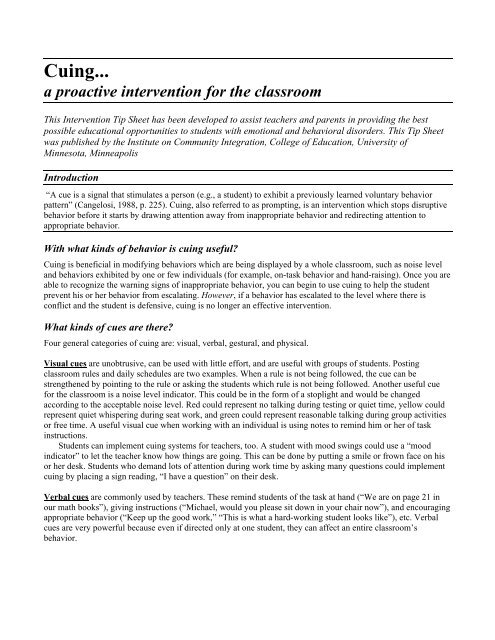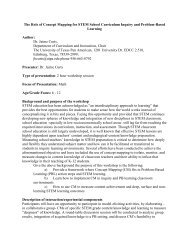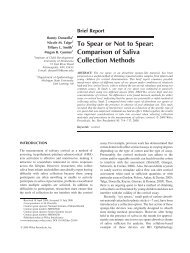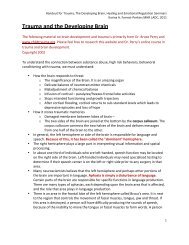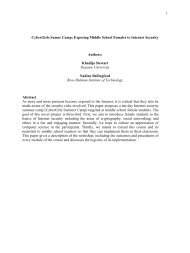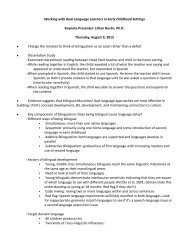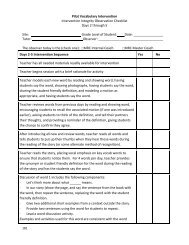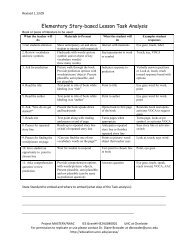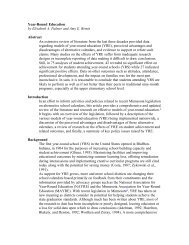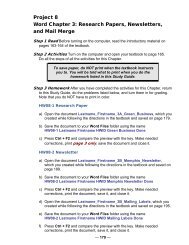Introduction to Positive Ways of Intervening with Challenging Behavior
Introduction to Positive Ways of Intervening with Challenging Behavior
Introduction to Positive Ways of Intervening with Challenging Behavior
Create successful ePaper yourself
Turn your PDF publications into a flip-book with our unique Google optimized e-Paper software.
Cuing...<br />
a proactive intervention for the classroom<br />
This Intervention Tip Sheet has been developed <strong>to</strong> assist teachers and parents in providing the best<br />
possible educational opportunities <strong>to</strong> students <strong>with</strong> emotional and behavioral disorders. This Tip Sheet<br />
was published by the Institute on Community Integration, College <strong>of</strong> Education, University <strong>of</strong><br />
Minnesota, Minneapolis<br />
<strong>Introduction</strong><br />
“A cue is a signal that stimulates a person (e.g., a student) <strong>to</strong> exhibit a previously learned voluntary behavior<br />
pattern” (Cangelosi, 1988, p. 225). Cuing, also referred <strong>to</strong> as prompting, is an intervention which s<strong>to</strong>ps disruptive<br />
behavior before it starts by drawing attention away from inappropriate behavior and redirecting attention <strong>to</strong><br />
appropriate behavior.<br />
With what kinds <strong>of</strong> behavior is cuing useful?<br />
Cuing is beneficial in modifying behaviors which are being displayed by a whole classroom, such as noise level<br />
and behaviors exhibited by one or few individuals (for example, on-task behavior and hand-raising). Once you are<br />
able <strong>to</strong> recognize the warning signs <strong>of</strong> inappropriate behavior, you can begin <strong>to</strong> use cuing <strong>to</strong> help the student<br />
prevent his or her behavior from escalating. However, if a behavior has escalated <strong>to</strong> the level where there is<br />
conflict and the student is defensive, cuing is no longer an effective intervention.<br />
What kinds <strong>of</strong> cues are there?<br />
Four general categories <strong>of</strong> cuing are: visual, verbal, gestural, and physical.<br />
Visual cues are unobtrusive, can be used <strong>with</strong> little effort, and are useful <strong>with</strong> groups <strong>of</strong> students. Posting<br />
classroom rules and daily schedules are two examples. When a rule is not being followed, the cue can be<br />
strengthened by pointing <strong>to</strong> the rule or asking the students which rule is not being followed. Another useful cue<br />
for the classroom is a noise level indica<strong>to</strong>r. This could be in the form <strong>of</strong> a s<strong>to</strong>plight and would be changed<br />
according <strong>to</strong> the acceptable noise level. Red could represent no talking during testing or quiet time, yellow could<br />
represent quiet whispering during seat work, and green could represent reasonable talking during group activities<br />
or free time. A useful visual cue when working <strong>with</strong> an individual is using notes <strong>to</strong> remind him or her <strong>of</strong> task<br />
instructions.<br />
Students can implement cuing systems for teachers, <strong>to</strong>o. A student <strong>with</strong> mood swings could use a “mood<br />
indica<strong>to</strong>r” <strong>to</strong> let the teacher know how things are going. This can be done by putting a smile or frown face on his<br />
or her desk. Students who demand lots <strong>of</strong> attention during work time by asking many questions could implement<br />
cuing by placing a sign reading, “I have a question” on their desk.<br />
Verbal cues are commonly used by teachers. These remind students <strong>of</strong> the task at hand (“We are on page 21 in<br />
our math books”), giving instructions (“Michael, would you please sit down in your chair now”), and encouraging<br />
appropriate behavior (“Keep up the good work,” “This is what a hard-working student looks like”), etc. Verbal<br />
cues are very powerful because even if directed only at one student, they can affect an entire classroom’s<br />
behavior.


